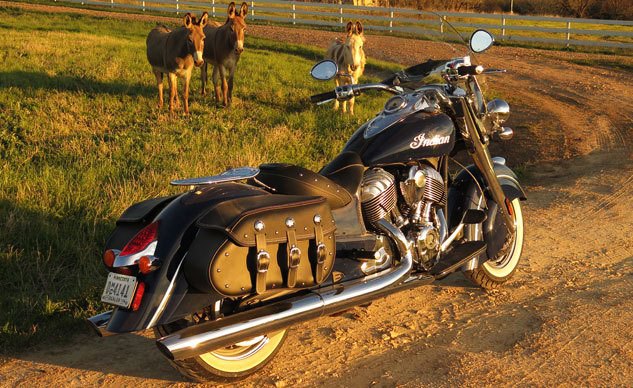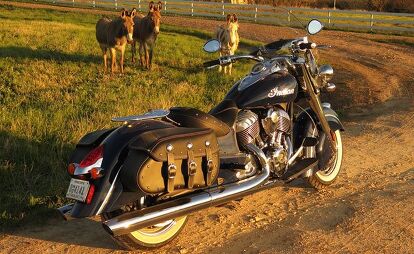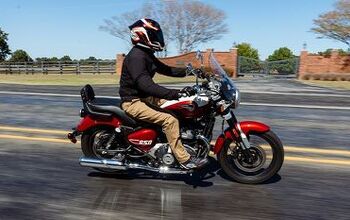Are Inner Tubes on Big Cruisers a Bad Idea?
Ask MO Anything: How retro should one go?
Dear MOby,
Next spring I’m planning – after my 2016 FLHXSE – to buy an Indian Chief Vintage. What irritates me a little big bit is the fact that it comes, vintage committed, with wire-spoke wheels that require tubes. Can you drop me a few bullets about that? Out of your big experience, is this a security issue? Is it talked about anyway? Would you recommend to just ride and don’t think about further?
Interestingly I didn’t find any shops who offer tubeless wire-spoke wheels for heavy cruisers. Where else than in God’s own country would there be more expertise about cruisers?
Kind regards from Vienna,
Gerhard
Dear Gerhard,
How are the sausages this year? Ahhh, not to think about such things further can be a mistake. Since you asked about my experience, all I can tell you is that I did experience a spot of unpleasantness on just such a heavy Indian cruiser a few years ago when I reviewed an Indian Chief Classic in Texas. Here’s an excerpt:
“… it [the Indian] shows no mercy when dealing with potholes and bumps. And whatever its suspension can’t handle is crushed beneath its massive weight and thick, cushy seat. Just keep the gas on and steer with the wide handlebar.
The other thing its massive weight had no mercy for was its rear Dunlop American Elite tire. On my way to College Station one bright morning, I felt a wiggle that felt like a flat and pulled onto the shoulder, where I was enveloped by a cloud of rubber smoke. What the? No flat kit was going to fix the exit wound in this tire, so I was relieved I hadn’t brought one. The very nice lady at AAA informed me over the phone that since I hadn’t paid the extra $7 for motorcycle and RV coverage on my policy, I was on my own. The flatbed driver was nice as could be, but it was a $200, 20-mile ride to Mancuso H-D on the Houston outskirts. They were nice as hell at the massive Harley-Davidson dealership, but also apologetic that they had no 180/65-16 tires in stock, which is surprising since that’s a really common size on all kinds of Harleys.
They were kind enough to kick me up the road to Global Motorsports, where it at first appeared that my valve stem had somehow gone missing in action, until it became clear that it was in fact the stem and the inner tube it was attached to that were all gone. Ed and crew were not only nice as all get-out, they even fixed me up with a new blackwall Dunlop and tube for $321.33, which didn’t seem entirely unreasonable given they had to drop everything they were doing and remove a muffler to get the tire off and on. On the positive side, if you’re going to spend most of a day dealing with a blow-out, maybe it’s good to have it happen on one when you were scheduled to visit the George Bush Presidential Library.”
Later, attempting to get to the bottom of what caused this, Dunlop said this can happen in rare instances if the tire is underinflated. I must admit I did not check my pressures that morning, but in pictures of the bike I’d shot that morning, the rear tire didn’t look low. Not that that means anything.
I’ve heard horror stories from a few different tire company people who set up inflation stations at big rallies as a courtesy to check peoples’ psi and promote rubber goodwill. They all agree that underinflation is a huge problem, and are surprised there aren’t more tire failures than there are as a result. An 800-pound motorcycle with two large Americans and most of their worldly possessions bungeed atop two bald tires with 12 psi is not an uncommon sight.
Anyway, a tube inside there is only going to create more friction, friction creates heat, and heat can lead to what happened to the rear tire on my Indian. Tire manufacturers are of course loathe to admit anything can go wrong with their product. But asked, which is more liable to cause a problem – an underinflated tube tire or an underinflated tubeless tire? – one tire guy who’s been in the business a looong time wrote me: “An underinflated tube tire will overheat itself to failure of some kind.” (He also mentioned how they’d put tubes in race bikes back in the day to get the tires hot on cold days…)
The answer to your question then, is, you’ll probably be fine on those wire-spoke wheels and tubes if – and it’s a tremendous if – if you check your tire pressures religiously! Like, get down on your knees at least a couple times a week and check them.
Personally, I’m a fan of the convenience provided by being able to just shove a plug into a tubeless tire whenever fate decrees it necessary, which seems increasingly frequent in these parts.
On the Indian Build-a-Chief website, if I was going to be cruising around at speed in Europe, I’d probably check the “10-Spoke Wheel” option, front and rear. They’re $499.98 apiece over here.
Send your moto-related questions to AskMOAnything@motorcycle.com. If we can’t answer them, we’ll at least make you feel temporarily better by thinking you’re talking to somebody who cares even if we don’t. And remember, only the Pope is infallible. But we probably know more about motorcycles.
Recent Ask MOs:
What are Tire Balancing Beads?
Why Do Nails Only Puncture REAR Tires?
Why is My Suspension So Stiff?
More by John Burns


































Comments
Join the conversation
Product designers who spec spoke wheels for the sake of nostalgia should be forced to repair a flat on the side of the road with nothing but a standard tool kit and a six-inch flat-blade screw driver. In the rain. At night. That'll fix 'em.
I own an Indian Chief Vintage with Spoke Wheels and Whitewalls. I would not want it any other way. The Rim Profiles are tubeless and it wears Tubeless Tires, but is fitted with Tubes nevertheless – due to the (vintage) manner the Rims are laced, I guess.
So, I fitted an Outex® Tubeless Conversion Kit for Spoke Wheels (the closest being the FR-HD16305 Front 16x3.00 + Rear 17x6.00 set for FLSTSB Crossbones) purchased direct from www.ronin-cycles.com (Japan). Outex® Kits are very popular on older Ducatis wearing Laced Wheels and are well Track-day-proven to boot. Ronin Cycles stock several sizes for the more popular Spoke-wheel Harleys, amongst others. The Front Wheel is now truly tubeless. The Rear still runs a Tube though given the oversized Valve Opening in the Rim for the (equally oversized) Valve Reinforcement on the Vintage’s Rear Tube. Around 18-19 mm diameter if I remember correctly – nobody makes a Tubeless Valve that can fit a hole that size, they are generally 5/8” maximum. Anyway, the rapid-blowdown leak paths are all dealt with now. I have been running like that for close to a year now, around 8 000 km, and it keeps pressure very well. I also fitted TireGard® (13-315U) Wireless TPMS.
It took me a full day to fit the Outex® Kit to the two Wheels. Add one more day to
remove and refit both Wheels on a Chief! Watch the Outex® YouTubes, read and reread the Instructions. Oh, and be sure to follow them too! It was my first time doing it – and if I can do it, anybody can. Most other Bikes will probably not share the Vintage’s Rear Valve issue, meaning both Wheels can be truly tubeless after the Outex® Conversion.